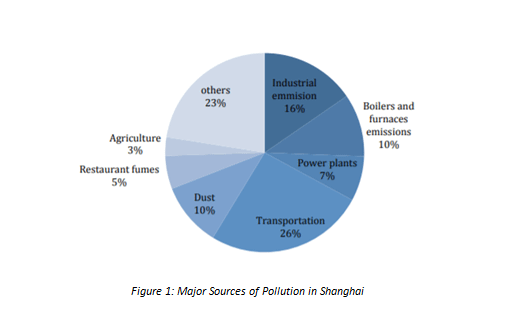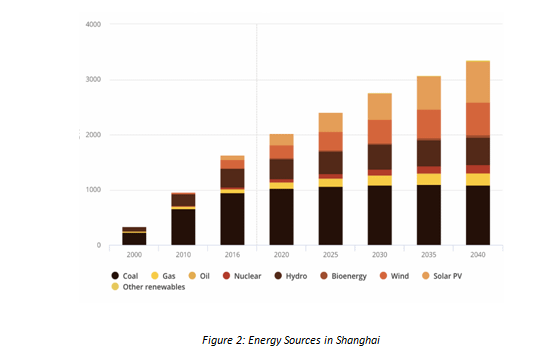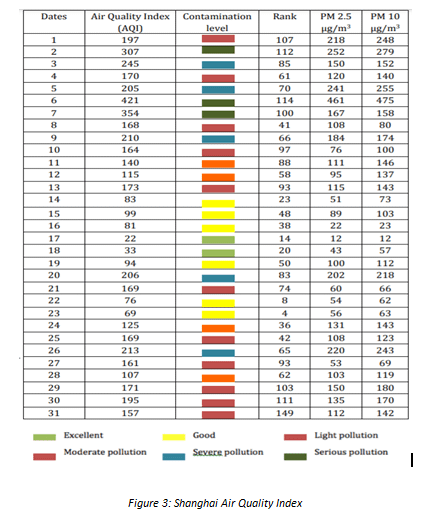Title: TO WHAT EXTENT CARBON MONOXIDE AFFECTS SHANGHAI’S AIR QUALITY
Category: Coursework
Sub Category: Essay
Subject: Sustainable Business Practices
References: APA
Research Question: To what extent carbon monoxide affects Shanghai air quality?
Introduction:
The science behind the basic functioning of this world is defined as Nature. Nature includes, but is not limited to, rain, erosion, forestation and deforestation, snowfall, etc. The scientists who spend their life conducting research, to find answers for various queries, are actually researching on the nature of our Earth. Nature, however, does not operate in a cyclical system. It often shows its power through seasonal torrential rains, floods, storms and earthquakes (N. Chen et al., 2020).
Recently, in the last two centuries, the Earth’s nature has changed significantly, causing temperatures to rise, rising sea level, unexpected rains, droughts and glaciers to melt. This rapid change can be attributed to human being’s activities. With the rapid industrialization, we started using a variety of resources that were previously hidden under the Earth. Utilizing these resources, resulted in the creation of waste, which released poisonous substances that polluted the land, air and water (Huang, Pan & Guao, 2018).

One of the many countries on this planet is China. China is considered an economic power and one of the most industrialized economies of modern times. The western developed considers China as a giant factory, because almost all manufacturing related activities are outsourced by the western countries, to China. Conducting manufacturing related activities on such a large scale has resulted the country to become polluted. Despite the Chinese government’s efforts the country still has to deal with a toxic air. In this paper, I will discuss the air pollution in Shanghai, and how one greenhouse gas; Carbon Monoxide, impacts Chinese air quality (Lu, Xhing & Zhang, 2020).
Air Pollution:

For most Chinese, air pollution is a familiar phenomenon. They can see a colored haze settled over their cities, or billowing across the highways. In certain areas, the local people cannot see the air pollution, but they can smell the pungent scent(Rohde & Muller, 2015).
Air pollution can be referred to as a mixture of various hazardous substances that are generated from both; manmade and natural sources. Man-made sources can include the burning of fuel to power automobiles, factories, power plants and discharge of pungent smells from the garbage that rots at landfills. On the other hand, natural sources of air pollution include the release of toxic substances from wildfire, volcanic eruptions and the decomposition of organic material in the soil (Yin, Brauer & Cohen, 2020).
With time, humans have become more tech savvy. Today, people tend to do the smallest of things with the help of technology. Automobiles are a relatively recent invention, as they were invented less than one and half century ago. Automobiles have solved an essential problem we had to face: travel. However, they are also one of the causes of air pollution. The harmful greenhouse gases; like carbon monoxide, sulfur oxide and nitrogen oxide, are emitted from cars when they burn fuel (Wu, Dai, Gang & Xi, 2017).
[Get best coursework writing service from expert to boost your grades]
Air Pollution in China:

Pollution in China is a hot topic among environmentalists. They have often claimed that China; which is the largest consumer of coal, puts the whole world at risk by contributing greenhouse gases to our Ozone layer. In fact, not just us but the Chinese themselves have witnessed certain diseases caused by air pollution (Zhang, 2018).
The good thing is that the Chinese government knows the danger air pollution poses for the country, Henceforth, the current Chinese government has taken considerable steps to fight against air pollution. In 2019, China reported the lowest PM2.5 in its history and if the current trend continues, Beijing might drop out of the list of Top 200 most polluted cities on Earth. This shift can be attributed to China’s move from coal fired power plants to natural gas plants (Zheng, 2015).
To reduce air pollution, the Chinese government has imposed stricter regulations. The State Council launched an Action Plan for the Prevention and Control of Air Pollution some time ago. The plan aims to lower the PM2.5 by more than 10 percent, by switching to renewable energy sources. The renewable energy sources China is interested in are nuclear, hydro and natural gas. This will be done in different phases, which include the closure of steel, cement, aluminum and thermal power plants. This will reduce the generation of air pollution and allow the country to use much better substances (Millman, 2008).
Air Quality of Shanghai:

Shanghai is one of the four main areas in China. It comes under the control of the State Council of China. The city lies south of the Yangtze, along the Huangpu River. Shanghai has a population of 25 million, which makes it the most crowded metropolitan territory in China, and the third most crowded city on Earth. Shanghai is a center for research, innovation, finance, manufacturing and transportation. The Port of Shanghai is considered the world’s busiest container port, because of its heavy trade with the rest of the world (Cao, 2009).
Planning the Investigation:
In this investigation, my aim is to find out the extent to which greenhouse gas; like Carbon monoxide, has an impact on the air the people of Shanghai breathe. Has Carbon monoxide actually changed the air quality and made it difficult for the local people to breathe, and is it possible for the Chinese government to amend the losses. I would go through various past research papers and the information available on the China’s Air Quality Index measurement website (Sperling, 2005).
The Problem:
The Consulate of the United States of America has an air quality monitor which measures the PM2.5 particles to analyze the air quality of China. The pollutants in air; like the dust particles, are related to a variety of health related problems. The health problems; or diseases cause a great deal of damage to the more sensitive portions of the population; like children and senior citizens, who suffer from respiratory, skin or heat diseases (Dong, 2019).
Shanghai being a highly industrialized city of China, is prone to pollution. Last year, in 2020, almost 49, 000 people died in Shanghai due to air pollution. According to the Center for Research on Energy and Clean Air, these deaths have resulted in a loss of $23 billion for the nation. These losses are in spite of the fact that most industries were shut down because of the coronavirus lockdown (Cai, 2014).
Experts have claimed that Shanghai has more concentration of Sulphur dioxide and nitrogen dioxide compared to other Chinese cities. The CREA experts claim that such hazardous air quality has caused a health damage of a range of 0.4 and 6 percent to the national GDP, last year. The air pollution has also resulted in many citizens of Shanghai to be permanently diagnosed with chronic illnesses; like asthma. This has further resulted in many Chinese nationals to be absent from their work for more than one week. This paper discusses this problem; how carbon monoxide impacts Shanghai air (Chen, 2018).
Controlling Variables:
Independent Variable: Carbon Monoxide
Dependent Variable: Shanghai air quality
Controlled Variable: The reading on PM2.5 measure, which calculates the air quality.
Materials:
• Laptop
• Google Scholar
• Internet connection
Method / Procedure:
In order to find out the air pollution level caused by the emission of carbon monoxide, and air quality of Shanghai and how it impacts the citizens of Shanghai, I have used the following methods;
• Literature available on the internet, related to air pollution in Shanghai will be used.
• The measurement on the PM 2.5 scale is used to analyze the air quality of Shanghai.
• It is known that the Consulate of the United States of America measures the air quality of People’s Republic of China, and regularly update this information on their website. I have taken this information for this paper.
• Documents issued by the Government of China; those that are available for public, are also cited.
Data Collection and Processing:
| No. of Articles | Objectives | Methodology | Findings | Recommendations |
| 1 | To study the potential effect of surrounding air pollution on health and economy of Shanghai. | Evaluated level of exposure for local people during different planned scenarios, and analyzed their impacts through concentration response orders. | Surrounding air pollution can have an impact on local resident’s health, physically and economically. | The connection between health and energy should be considered, when deciding economic and sustainable development. |
| 2 | China’s review of the air pollution control and transformation towards a responsible air quality management. | Review of the past three decade’s progress in air quality management. | Initially, acid rain was common. Though, emission control of greenhouse gases in accordance to the Action Plan has helped tremendously. | China needs a multi-objective road map to maintain air quality protocols. |
| 3 | Evaluation of the effects of Air Pollution Prevention and Control Action Plan, for air quality management and impact on health. | Analysis of local air quality monitoring data, and estimate of impact on health in Shanghai. | From 2013 to 2017, the concentration on the PM 2.5 scale decreased for Sulphur dioxide and carbon monoxide, but not for nitrogen dioxide. | Reduction of mortality, with respect to air pollution, was achieved in 2017, showing the efforts of the Chinese government. Though, there is still much to do. |
| 4 | To analyze the effect of air pollution in China. | Used methods of Global Burden of Diseases, Injury and Risk Factors to analyze deaths because of air pollution, and the projected life expectancy if air pollution was lesser. | In 2017, 1.24 million deaths were caused because of air pollution. Diseases like lower respiratory infections, diabetes, lung cancer and heart diseases became prevalent. | China should implement sustainable development policies to lower the impact of air pollution on local people’s health. |
| 5 | To investigate the impact of air pollutants on pediatric hospital admissions for Mycoplasma pneumonia in Shanghai. | Logistic regression was calculated the link between pediatric admissions for Mycoplasma pneumonia and air pollution. | It was found that pediatric hospital admission for pneumonia had positive relationship with increased concentrations of nitrogen dioxide and particulates. | The findings suggest that China needs a public health policy. |
| 6 | Investigate the reasons behind the formation of smog in Shanghai, and the nature of major PM2.5 factors. | Internet sources | The extremely negative weather condition is mainly related to the smog, though pollutants like coal, motor vehicles and factories also play a role. | Urban inhabitants need to consciously take part into the ecological protection work, upholding green and low carbon life, and friendly living and travel habits. The Shanghai government should make a good job in green environmental protection from the details. |
| 7 | To find the primary pollutants and analyze the air quality of urban China. | The comprehensive pollution index analysis method and the Euclid degree method. | Shanghai’s main pollutants are PM 2.5 and Ozone layer. Which mainly happens in the first half of the year. | The Chinese government should follow a road map which will allow it to reduce pollution. |
| 8 | Mapping the key areas with concentration of air pollution. | Kriging Interpolation | Wellsprings of contamination are inescapable, yet are especially serious in an upper east passageway that reaches out from close Shanghai to north of Beijing. During our investigation period, 92% of the number of inhabitants in China experienced >120 long periods of undesirable air (US EPA standard), and 38% experienced normal focuses that were unfortunate | The Chinese government ought to follow a guide which will permit it to lessen contamination. |
| 9 | Decline of air pollution n during the Coronavirus lockdown. | All observational information with the exception of those utilized for the examination in Beijing are given by the 1641, operational stations (1605 stations in 2019) of the China Environmental Observation Network worked by the China National Environmental Monitoring Center | We locate that, by and large, the degrees of surface PM2.5 and NO2 have diminished by around 35 and 60%, separately, between the time frame 1-22 January 2020 and the period 23 January-29 February 2020. Simultaneously, the mean ozone fixation has expanded by a factor 1.5. | The examination of the surface grouping of essential and optional species estimated at the checking stations worked in northern China uncovers a solid progress in air contamination as one crosses the date of the lockdown forced to China because of the COVID-19 flare-up. |
Discussion:
After going thru with the previous articles given above, it is clear that Shanghai has a lot of air pollution. This has taken a toll on its people, who have been forced to become health patients, at the expense of economic success. China apparently, would have to come up with an Action Plan, which it follows strictly, so as to get rid of the air pollution(Chao, 1991).
[Acquire Assistance From Expert’s Coursework Writer and boost your grades]
References:
Cai, J., Zhao, A., Zhao, J., Chen, R., Wang, W., Ha, S., Xu, X., & Kan, H. (2014). Acute effects of air pollution on asthma hospitalization in Shanghai, China. Environmental Pollution, 191, 139–144. https://doi.org/10.1016/j.envpol.2014.04.028
Cao, J., Li, W., Tan, J., Song, W., Xu, X., Jiang, C., Chen, G., Chen, R., Ma, W., Chen, B., & Kan, H. (2009). Association of ambient air pollution with hospital outpatient and emergency room visits in Shanghai, China. Science of The Total Environment, 407(21), 5531–5536. https://doi.org/10.1016/j.scitotenv.2009.07.021
Chao, Z. (1991). Urban climate and air pollution in Shanghai. Energy and Buildings, 16(1), 647–656. https://doi.org/10.1016/0378-7788(91)90033-Y
Chen, C., Liu, C., Chen, R., Wang, W., Li, W., Kan, H., & Fu, C. (2018). Ambient air pollution and daily hospital admissions for mental disorders in Shanghai, China. Science of The Total Environment, 613–614, 324–330. https://doi.org/10.1016/j.scitotenv.2017.09.098
Chen, N., Shi, J., Huang, J., Yu, W., Liu, R., Gu, L., Yang, R., Yu, Z., Liu, Q., Yang, Y., Cui, S., & Wang, Z. (2020). Impact of air pollutants on pediatric admissions for Mycoplasma pneumonia: A cross-sectional study in Shanghai, China. BMC Public Health, 20(1), 447. https://doi.org/10.1186/s12889-020-8423-4
Dong, D., Xu, X., Xu, W., & Xie, J. (2019). The Relationship Between the Actual Level of Air Pollution and Residents’ Concern about Air Pollution: Evidence from Shanghai, China. International Journal of Environmental Research and Public Health, 16(23), 4784. https://doi.org/10.3390/ijerph16234784
Huang, J., Pan, X., Guo, X., & Li, G. (2018). Health impact of China’s Air Pollution Prevention and Control Action Plan: An analysis of national air quality monitoring and mortality data. The Lancet Planetary Health, 2(7), e313–e323. https://doi.org/10.1016/S2542-5196(18)30141-4
Lu, X., Zhang, S., Xing, J., Wang, Y., Chen, W., Ding, D., Wu, Y., Wang, S., Duan, L., & Hao, J. (2020). Progress of Air Pollution Control in China and Its Challenges and Opportunities in the Ecological Civilization Era. Engineering, 6(12), 1423–1431. https://doi.org/10.1016/j.eng.2020.03.014
Millman, A., Tang, D., & Perera, F. P. (2008). Air Pollution Threatens the Health of Children in China. PEDIATRICS, 122(3), 620–628. https://doi.org/10.1542/peds.2007-3143
Rohde, R., & Muller, R. (2015). Air Pollution in China: Mapping of Concentrations and Sources. PloS One, 10, e0135749. https://doi.org/10.1371/journal.pone.0135749
Sperling, D. (n.d.). TONGI UNIVERSITY, SHANGHAI. 54.
Wu, R., Dai, H., Geng, Y., Xie, Y., Masui, T., Liu, Z., & Qian, Y. (2017). Economic Impacts from PM2.5 Pollution-Related Health Effects: A Case Study in Shanghai. Environmental Science & Technology, 51(9), 5035–5042. https://doi.org/10.1021/acs.est.7b00026
Yin, P., Brauer, M., Cohen, A. J., Wang, H., Li, J., Burnett, R. T., Stanaway, J. D., Causey, K., Larson, S., Godwin, W., Frostad, J., Marks, A., Wang, L., Zhou, M., & Murray, C. J. L. (2020). The effect of air pollution on deaths, disease burden, and life expectancy across China and its provinces, 1990–2017: An analysis for the Global Burden of Disease Study 2017. The Lancet Planetary Health, 4(9), e386–e398. https://doi.org/10.1016/S2542-5196(20)30161-3
Zhang, L. (2018, June). Regulation of Air Pollution [Web page]. https://www.loc.gov/law/help/air-pollution/china.php
Zheng, J., Jiang, P., Qiao, W., Zhu, Y., & Kennedy, E. (2015). Analysis of air pollution reduction and climate change mitigation in the industry sector of Yangtze River Delta in China. Journal of Cleaner Production, 73. https://doi.org/10.1016/j.jclepro.2015.07.011

